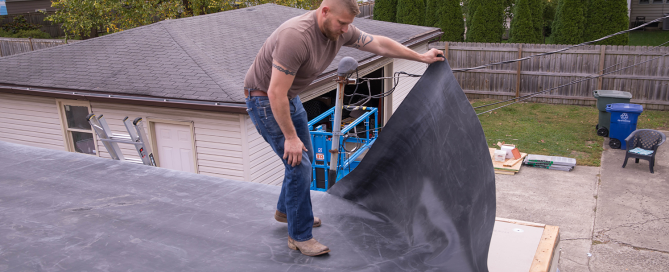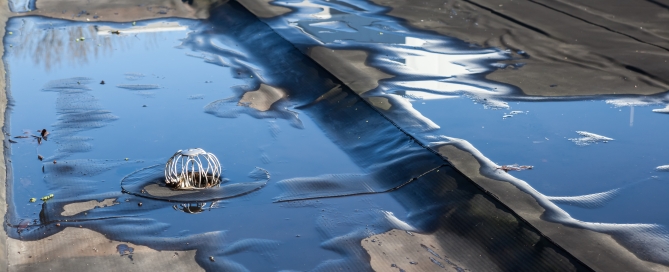Advantages of EPDM Over Asphaltic – Based Single – Ply Systems
When it comes to selecting a flat roofing systems, durability, performance, and sustainability are critical factors in making the right choice. EPDM (ethylene propylene diene terpolymer) roofing systems have numerous advantages over options like asphaltic-based single-ply systems. These advantages make EPDM an excellent solution for both commercial and residential roofing projects.
Longevity and Durability
EPDM roofs have an industry-leading lifespan, often exceeding 30 years, with proper care and maintenance. Their rubber composition provides superior resistance to:
- Cracking
- UV exposure
- Weather-related damage
Additionally, when installed correctly, EPDM can withstand years of wear and tear, making it one of the most reliable roofing materials available.

Weather Resistance
One of the standout qualities of EPDM is its excellent weather resistance. It holds up against extreme conditions, including high winds, hailstorms, heavy rain, and even snow. This durability makes it an ideal roofing solution for a wide variety of climates, from freezing temperatures to scorching heat, ensuring consistent protection for your building year-round.
Improved Flexibility
EPDM stands out for its flexibility, especially in cold temperatures where other materials may become rigid and prone to cracking. This flexibility reduces the risk of damage during freeze-thaw cycles, ensuring that the material can expand and contract with temperature changes without compromising its integrity. Unlike asphaltic systems, which tend to lose flexibility over time, EPDM can maintain this important feature for decades.
Lightweight Material
EPDM is a lightweight material that places less stress on your building’s structure compared to heavier alternatives such as asphalt. Its reduced weight not only simplifies installation but also minimizes long-term structural wear. This reduced wear makes EPDM an excellent choice for retrofits and new construction projects where efficiency and structural preservation are important.
Superior UV Resistance
EPDM’s exceptional UV resistance is another feature that sets it apart. Unlike other materials that degrade quickly under constant sun exposure, EPDM’s rubber composition can withstand prolonged UV rays without significant wear. This resistance prolongs the life of the roofing membrane and reduces the likelihood of costly repairs due to sun damage.
Reduced Maintenance Needs
EPDM roofs deliver long-term performance with minimal upkeep. Unlike asphalt-based systems that may require frequent inspections and repairs, EPDM’s resilience and simple design reduce maintenance demands. Over time, reduced maintenance allows building owners to save time and money over the years while enjoying reliable protection against the elements.
Cost-Effective Over Time
While the upfront cost of EPDM may be similar to asphaltic systems, the real value lies in its long-term savings. Thanks to its durability, reduced maintenance, and energy efficiency, EPDM proves to be a cost-effective investment. Over its lifespan, building owners can save significantly on repairs, replacements, and energy expenses.
Resistance to Ponding Water
EPDM’s exceptional resistance to ponding water makes it an ideal choice for flat or low-slope roofs, which often experience standing water after heavy rainfall or snowmelt. Unlike asphaltic systems, which can degrade or blister quickly when exposed to standing water for prolonged periods, EPDM remains intact and maintains its performance.
This durability means fewer repair needs and a longer lifespan, even in challenging weather conditions. For building owners in climates with frequent rain or storms, EPDM provides a worry-free solution that ensures consistent protection against water damage.
Better Energy Efficiency
EPDM membranes are available in both black and white options, offering building owners flexibility in optimizing energy efficiency based on their specific climate needs. Black EPDM absorbs heat, making it a smart choice for colder regions where maintaining warmth inside the building is a priority. This heat-absorption can lead to lower heating costs during winter months.
On the other hand, white EPDM reflects sunlight, which reduces heat absorption and helps lower cooling costs in warmer climates. This reflective capability also reduces urban heat island effects, contributing to more sustainable urban environments.

Environmental Friendliness
Choosing EPDM is a step toward greener building practices. The material is not only highly durable but also extremely recyclable, often being repurposed into new products at the end of its lifespan. This minimizes waste and reduces the environmental impact of construction projects.
In contrast, asphaltic systems are less environmentally friendly, often ending up in landfills after their use. The production process for EPDM also has a smaller carbon footprint compared to many traditional roofing materials. When you choose EPDM, you support sustainability and help create a healthier planet.
Chemical Resistance
EPDM can resist a wide range of chemicals, making it an ideal choice for buildings in industrial settings or areas exposed to pollutants, harsh cleaning agents, or chemical byproducts. Its ability to withstand exposure to these substances without breaking down ensures long-term reliability and consistent performance.
Unlike asphaltic membranes, which may degrade or lose their structural integrity under similar conditions, EPDM retains its strength and protective properties. This resistance makes it an excellent solution for warehouses, factories, and other facilities that operate in demanding environments.
Easy Repairs
Even the most durable roofs may experience damage over time, but repairing EPDM is quick, simple, and cost-effective. Small tears, punctures, or damage caused by debris can be patched with minimal effort, reducing downtime and repair costs.
Unlike asphaltic-based systems, which often require extensive labor, specialized equipment, or complicated processes, EPDM repairs are straightforward and accessible. This ease of maintenance is particularly beneficial for building owners who want a roof that can stand strong through the test of time.
Proven Track Record
EPDM has been a trusted and reliable roofing solution for over 50 years, with a long history of superior performance in real-world applications. Its durability, versatility, and resistance to environmental factors have made it a go-to choice for countless commercial and residential structures.
From extreme weather conditions to everyday wear and tear, EPDM has consistently proven its ability to perform under pressure. EPDM’s proven track record offers peace of mind, knowing you’re investing in a high-quality material that will stand the test of time. Its reputation as a superior alternative to asphaltic systems ensures confidence in its performance and durability for years to come.
EPDM roofing systems provide many advantages over asphaltic-based single-ply systems, making them the right choice for you and your roof. When you choose EPDM, you can count on consistent reliability, reduced maintenance, and long-term cost savings. Whether you’re working on a residential or commercial project, EPDM delivers the advantages you need, and you can get your EPDM flat roof rubber membrane from us at RoofKit Roofing.




